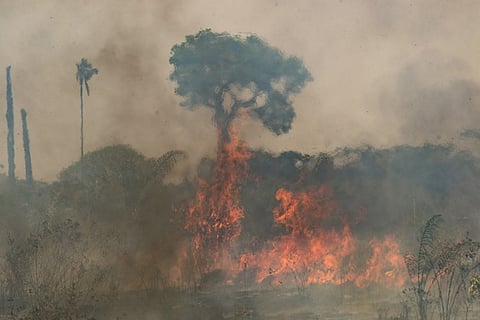

Chennai
This year, President Jair Bolsonaro pledged to control the burning — typically started by local farmers to clear land for cattle or to grow soybeans, one of Brazil’s top exports. He imposed a four-month ban on most fires and sent in the army to prevent and battle blazes.
But this week the smoke is again so thick around Novo Progresso that police have reported motorists have crashed because they can’t see. As smoke wreaths Novo Progresso, this year’s burning season could determine whether Bolsonaro, an avid supporter of bringing more farming and ranching to the Amazon, is willing and able to halt the fires. Experts say the blazes are pushing the world’s largest rainforest toward a tipping point, after which it will cease to generate enough rainfall to sustain itself, and approximately two-thirds of the forest will begin an irreversible, decades-long decline into tropical savannah.
But residents of Novo Progresso like businessman Claudio Herculano believe the city has only grown in the last few years because of increased ranching in the area. “It pains anyone to breathe this air,” Herculano, 68, said this week. “I have a little house uphill, and I do worry a bit that it could be destroyed. But all the people here are looking for better days, and we know what drives this economy.”
Bolsonaro is sending mixed signals: He greenlit an army-led operation to fight Amazon destruction in May, but then this month he denied the region’s trees can catch fire. Speaking at a video summit about the Amazon with fellow South American leaders, he also touted a year-on-year decrease in July deforestation data, omitting the fact it was still the third-highest reading for any month since 2015. “This story that the Amazon is burning is a lie,” he claimed, even as smoke from more than 1,100 fires wafted over the region that day.
On Monday and Tuesday of this week, reporters from AP did not see a single soldier in or around Novo Progresso. And this year could see more fires than last, according to Paulo Barreto, a forest engineer and deforestation researcher at environmental group Imazon. At the start of the Amazon’s dry season, in July, more trees had been felled, given that deforestation from August 2019 to July jumped 34% from the prior 12 months, according to preliminary data from Brazil’s space agency. Typically, after felling, the next step is burning, usually without the required authorisation — since it’s a far easier and cheaper way than using heavy machinery to clear brush and trees. Further, forest area degraded by logging — which is much more susceptible to wildfire than native forest — surged 465%, Barreto said.
August and September are when the burning kicks into overdrive. And in the first half of August, satellites detected 19,000 fires across Brazil’s Amazon — putting the month on track to match August 2019’s blazes that drew global outcry.
Associated Press
Visit news.dtnext.in to explore our interactive epaper!
Download the DT Next app for more exciting features!
Click here for iOS
Click here for Android